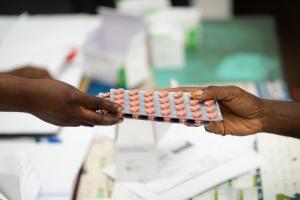Beating the resistance: tuberculosis treatment switch in Zimbabwe
Harare – Nothando Moyo* contemplated giving up treatment for multidrug-resistant tuberculosis “even if it meant I would die,” she admits. The months-long treatment for the drug-resistant strain—which does not respond to the two most effective drugs—entailed daily injections which Moyo, a resident of Zimbabwe’s Bulawayo city, found painful to bear.
Until a few years ago, the treatment regimen for multidrug-resistant tuberculosis could last up to two years.
“Many people were defaulting due to painful injections. The side effects were also severe,” says Judith Gumbo, a nurse in charge of tuberculosis treatment at Gwanda Provincial Hospital in southwest Zimbabwe.
In 2019, Zimbabwe introduced an all-oral treatment regimen for multi-drug resistant tuberculosis, an alternative recommended by the World Health Organization (WHO). The nine-to-12-month new regimen cuts treatment time by half and has been proven easier for patients to complete.
Tuberculosis is one of the leading causes of death in Zimbabwe. The African region has the second-highest tuberculosis burden worldwide, after Southeast Asia. Under the WHO End Tuberculosis Strategy, countries should aim to reduce tuberculosis cases by 80% and cut deaths by 90% by 2030 compared with 2015.
Multidrug-resistant tuberculosis, however, remains a major public health problem. Globally, over 150 000 cases of the resistant strain were detected in 2020. In Zimbabwe, 245 cases were recorded in 2021, a slight increase from the 227 recorded the year before.
Most tuberculosis patients are cured by a strictly followed six-month drug regimen. But mismanagement of treatment and person-to-person transmission have driven up multidrug resistance.
Misuse of antimicrobial drugs, ineffective formulations (such as use of single drugs, low-quality medicines or poor storage conditions), and premature treatment interruption can cause drug resistance, which can then be transmitted, especially in crowded settings.
Multidrug-resistant tuberculosis can be controlled by curing the patient the first time around, improving access to diagnosis, upgrading infection control in treatment facilities, and using recommended second-line drugs appropriately.
All in
In Zimbabwe, all multidrug-resistant tuberculosis patients are now enrolled in the shorter treatment schedule.
“We have better treatment outcomes now compared to previous years,” says Dr Charles Sandy, Deputy Director of the Tuberculosis Unit at Zimbabwe’s Ministry of Health and Child Care, adding that patient fatigue and dropout have been significantly reduced.
The new treatment has also proven easier to implement during the COVID-19 pandemic, which initially constrained delivery of essential health services.
“Oral medicines reduce the need to visit health facilities in person,” Dr Sandy points out. “Patients on treatment can be supported closer to their homes by community health service providers.”
Despite the convenience and ease of use of the new regimen, challenges remain, including missing cases of multi-drug resistance tuberculosis, poorer treatment outcomes compared with drug-sensitive TB, as well as rapid changes in drug-resistant tuberculosis guidelines that makes it difficult for health care workers to keep up with capacity building activities.
Although Zimbabwe remains on the list for tuberculosis/HIV and multidrug-resistant tuberculosis, the country has made sufficient strides against the disease to have been removed from the list of high-burden countries for drug-sensitive tuberculosis.
The country has also embraced WHO-recommended diagnostics such as rapid molecular tests, that have been deployed in all secondary level health facilities, and the adoption of diagnostic equipment to detect second-line drug resistance has further boosted case detection.
These interventions, coupled with targeted screening for active tuberculosis among high-risk communities, have been key in addressing disruptions caused by COVID-19. And for Moyo, they have been a game-changer.
“Shorter, less painful treatment makes it easier to go on,” she says. “I’m grateful to have my quality of life back.”
----
*Name has been changed
